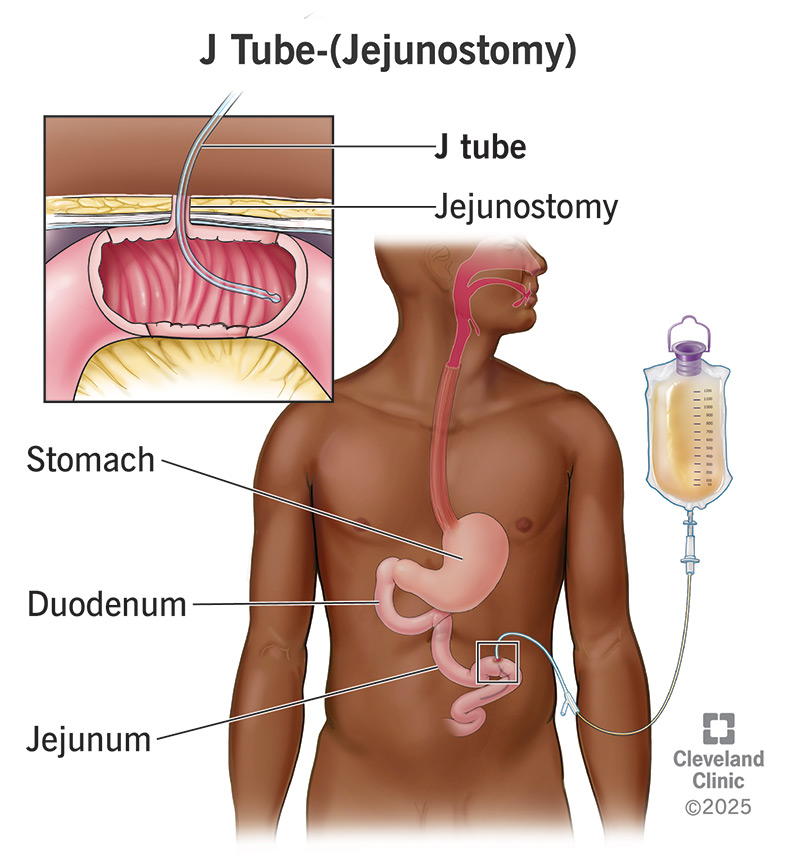A jejunostomy is a minor procedure to place a feeding tube (J tube) in your small intestine. Once in place, you can use it at home for as long as you need. You’ll learn how to use, clean and maintain your J tube, how to spot signs of complications and when to replace it.
Advertisement
Cleveland Clinic is a non-profit academic medical center. Advertising on our site helps support our mission. We do not endorse non-Cleveland Clinic products or services. Policy

A J tube (jejunostomy tube) is a feeding tube that a healthcare provider places in the midsection of your small intestine (jejunum). It’s a long-term feeding tube that you can use at home. Most people who need a jejunostomy tube will use it for at least six weeks. Some people may continue to use it for life.
Advertisement
Cleveland Clinic is a non-profit academic medical center. Advertising on our site helps support our mission. We do not endorse non-Cleveland Clinic products or services. Policy
The procedure to place the tube in your jejunum is called a jejunostomy. This is what the tube is named for. If your healthcare provider decides that a J tube is the right treatment for you, they’ll create a small opening in your abdomen for the tube to go in. The tube will stay in place for as long as you need it.
You might need a feeding tube to get nutrients and medicine into your digestive tract if you can’t get them by eating. Different types of feeding tubes connect to your digestive tract in different ways. A J tube goes directly into your small intestine through your abdomen. You might need this type of tube if:
Some conditions that might require a jejunostomy tube include:
Advertisement
Sometimes, healthcare providers place a J tube to deliver medicine. Medications that you take orally are sometimes more effective when they bypass your stomach and go directly to your small intestine. Your provider might try delivering your medicine this way if the oral way isn’t working well enough.
The procedure to place a J tube is called a jejunostomy. A jejunostomy is a minor procedure that creates a new opening (ostomy) in your intestine (jejunum) for the tube to go in. It goes in through another new opening in your abdomen (a stoma). Your surgeon will create these openings and then place the tube.
There are different ways of performing a jejunostomy to place a J tube. Some of these methods include:
This method uses endoscopy to place the J tube through your skin (percutaneously). A gastroenterologist guides a lighted enteroscope into your jejunum. The light allows them to locate it through your abdominal wall. They make a small incision over it to reach your jejunum.
This method uses laparoscopic surgery, a minimally invasive surgery technique. A surgeon makes three small incisions in your abdomen and places a laparoscope inside. The laparoscope transmits to a screen. Your surgeon operates with long, skinny instruments through the incisions.
Open surgery means your surgeon makes one larger incision in your abdomen instead of several small ones. Your surgeon will locate your jejunum and bring it to the surface of your abdomen. They’ll place the tube inside your jejunum and close the wound around the tube.
Your condition and your surgeon’s expertise will determine the type of procedure you have. Sometimes, a jejunostomy happens as part of a larger surgical procedure. Your surgeon will tell you what to expect and how to prepare for your procedure. In many cases, you can expect to go home on the same day.
Any surgery carries a small risk of complications, like infection or accidental injury to one of your organs. But these are uncommon. Most complications from having a J tube develop after the procedure and during daily use. These mostly relate to the J tube itself or the type of feeding formula you use.
Once your J tube is in place, you can use it for six to 12 months before you’ll need to replace it. Your healthcare team will show you how to clean and care for your J tube and your stoma. A dietitian will determine the best feeding formula for you to use. Not all foods or medicines can be used with a J tube.
It takes about two weeks for your stoma to heal. Until then, you’ll need to keep it dry and change the dressings daily. You’ll have some pain at the site, but it will get better each day. You can start feeding on the first day. Your healthcare team will make sure the feeding goes smoothly before sending you home.
Advertisement
How long you need to use your J tube will depend on the reason you need it. If your condition improves, your healthcare provider can remove your J tube and close your jejunostomy with a minor procedure. If you continue to benefit from having a J tube, you can replace the tube as many times as you need to.
Living with a J tube is a significant life change. On one hand, getting the nutrition and medication you need may improve your health enough to allow you to do more than before. On the other hand, you’ll have to adjust your routine around the practicalities of feeding. Here’s what you need to know:
Advertisement
Complications that can happen after your jejunostomy include:
Advertisement
See your provider if:
If you need help getting the nutrition you need, and a gastrostomy tube won’t work, a jejunostomy tube is your next best bet for long-term use. It's comfortable to use at home, with fewer complications than IV feeding. Learning to live with a J tube is an adjustment. But as your health improves, your life will, too.
If you have issues with your digestive system, you need a team of experts you can trust. Our gastroenterology specialists at Cleveland Clinic can help.

Last reviewed on 07/14/2025.
Learn more about the Health Library and our editorial process.